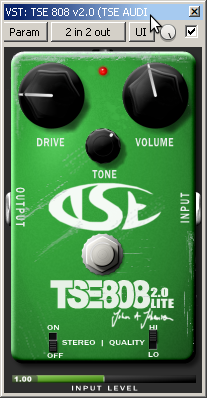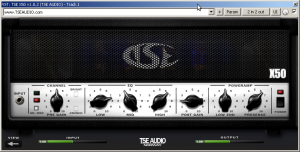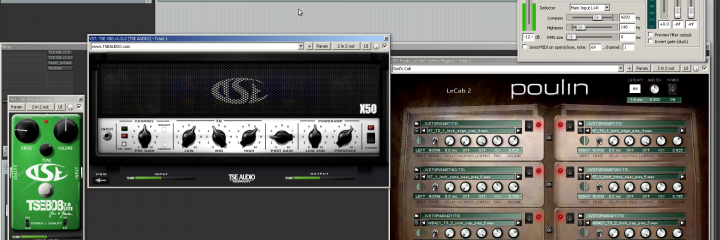While you’re recording your guitar during your home studio projects there’s something you want immediately right: your guitar tone. You want it aggressive, evil, distorted with great saturation and right EQ. What more? Nothing, the problem is that you have to render it as you’re actually thinking about it. That’s the hard part. Let’s start saying that this tutorial is for those guys who are starting their first studio project and who are trying to have more from their guitar sound. There’s no right or wrong way to do it, this is how I like to do it, keeping it the simpliest I can. Moreover I use free plugin, not bad for your wallet, isn’t it?
I’m not a guitar player, not at all, I play every now and then guitar just to remember some riffs and record them quickly, with my cheap SG guitar (I bought it some years ago for about 100€ on ebay), B drop tuned with some awesome strings: RotoSound DarkZone. I recorded some chords and some palm muted parts for this tutorial and, I mean, remember I’m not a guitar player, so forgive me! I use Reaper but you can apply all the concepts to whatever DAW you like.
Let’s move forward: create a new track and insert these FREE plugins:
- TSE TS808(version 2.0)
- TSE X50 (version 1.0.2)
- Poulin LeCab 2
- ReaGate
Insert them following exactly this order in your VST chain. It turned out mandatory for me to add a gate at the end, Reaper’s ReaGate to be precise, because of the annoying noise coming from my SG cheap pickup, that was amplified by the VST chain. I just loaded the “rhythm guitar” preset tweaking a bit the threshold, the noise disappeared. Another really important point to stress is to remember to enable monitoring, otherwise you’re not gonna hearing anything from your speakers! On Reaper mixer find the little button on the right of the track volume fader and click it. Please remember to enable it, or it would be hard to hear you playing 🙂
Let’s have a more detailed look to the VST chain. The TSE TS808 is a good quality tube driver emulator, don’t think about it as a poor quality plugin just because it’s free, I found really few ones like this, moreover a brand new release has been recently released, and trust me, it sounds even better. This is exactly what we need to give to our tone the right amount of grit before sending the signal to the amp, on palm muting it will be a blast. For this tutorial I set it this way:

TSE X50 is a free VST clone of the famous and “evil” Peavey 5150, massively used in extreme metal. Even this plugin recently got a new release: a must. If your target is an aggressive distortion, it won’t let you down. If you remember my post on guitar amp simulators comparison, I used an old X50 version and it was already really good for me, then I modified the post with the new version and I realized how much better it sounded. My SG gets a badass tone with this settings:

Poulin LeCab 2 it’s a quite versatile cabinet simulator, if you already own some IR wav files it’s exactly what you need. What’s an IR? The Impulse Response is a signal that can be extracted (with a slightly complex procedure maybe someday we’ll talk about it in details) recording the signal of a real cabinet with a microphone. To keep it simple we can say that it’s the “fingerprint” of the cabinet and the related microphone. Why it’s important? Because you really can’t take just the output signal of the amplifier without the cabinet, try to think about it as if you had a real amp, would you record the direct output of your amplifier head without the cabinet? It would be awful and somehow dangerous for your recording system. Don’t do it. Neither with VSTs 😉 In this case I used God’s Cab IRs, they’re free and come with a detailed user manual, that explain the different techniques used to record the IRs. Load the WAVs files on LeCab, if you blend together more than one IR it would be like if you’re micing your cabinet from different point, experimenting different combination is quite interesting, this is how I like it with God’s Cab:

Here you are my final tone:
As you can notice the sound need to be enhanced: it would be nice to add an highpass filter to cut everything under about 100Hz, then, lowpass everything above the frequency you hear “frying” on the upper part of the spectrum, usually these frequencies give to your tone a very digital character, it’s better to reduce it.
To summarize you can reach every sound you need just using free plugins you can find on the web, this is how I record my ideas and riffs, quickly and for free, I couldn’t ask for more 😉
Please note: this post participate to the “Group Writing Project: Write a ‘How To…’ Post” by ProBlogger, have a look to the project!


comments